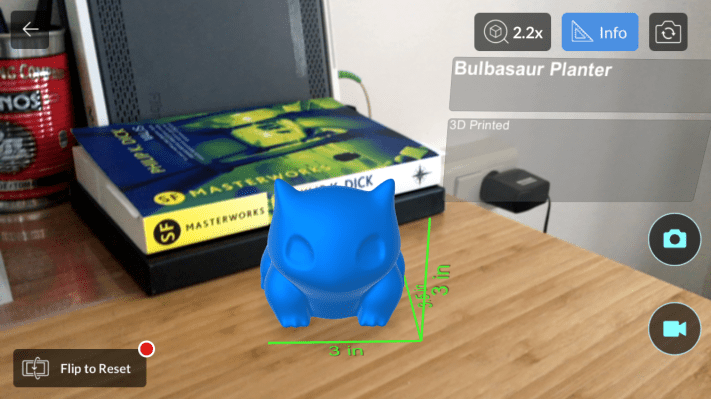What is augmented reality good for? Product visualization to encourage online shopping, reckons Santa Clara-based startup Apollo Box, which launched an online marketplace for an eclectic selection of lifestyle products almost a year ago — before spicing up the e-commerce experience with an AR feature called “Teleport.”
It’s been testing AR on its marketplace since last October with a subset of products, but is now opening up the technology to any brands selling via its platform.
The gift-focused marketplace has around 500,000 active users at this point, and an inventory of around 1,200 products from circa 450 vendors. Items range from jewelry and apparel, to ornaments and toys, to gadgets and more.
Since starting the augmented reality beta, the startup has sold 1,105 items involving the use of AR — or about 8.5 percent of all sales during the period, according to co-founder Will Li — and is crediting the tech with a 25 percent conversion rate boost.
Just 65 products are currently available on the marketplace for viewing in AR — about 5 percent of its total inventory — but Li is expecting this to step up substantially now that they’re opening the tech to all their vendors. “We believe more brands will work with us after this public launch, and we hope to reach 25 percent of our growing inventory in the next six months,” he says.
To enable products to be viewable on Apollo’s marketplace in AR, vendors send product images or models and the startup converts these to 3D files. It can also create simple animations so that potential buyers can further interact with the virtual products.
The Teleport feature generally lets shoppers view and place a 3D representation on a surface in their home — such as a desk or table where they might be intending the product to sit. It works on iPhone 5s or above and Android 5.0 devices and above.
“There are several companies offering AR-based technology solutions for displaying products, like Cimagine and Marxent. One key difference is that we provide a complete e-commerce solution with integrated AR features,” says Li.
“Many of the brands we work with are small and medium companies. They traditionally rely heavily on offline sales and don’t even have their own e-commerce websites or apps. Working with us, they don’t have to invest in building their apps to get products shown in AR,” he adds.
Apollo’s AR tech is markerless, which means it works without needing to print out or place a marker card in the physical location (as some other applications of AR do) — although this does mean the sizing of the virtual product is not necessarily accurate.
“On devices without depth sensor, we don’t know the exact distance between the camera and the surface to place the items,” confirms Li. “So we use an estimated value around 2 feet. It’s the distance between a standing person and an office desk in front. When users are placing items in this way, the displaying size will be correct. When users are pointing further or closer, the size goes wrong.”
Still, for Apollo Box’s mainly lifestyle product context, AR is largely functioning to help buyers get a general feel for something they’re thinking of buying.
This is about visualizing a set of oddly shaped ornaments on a mantlepiece or playing around with a cartoon dinosaur desk buddy — rather than trying to accurately refit a kitchen. So really AR is an added gimmick to help sell what are essentially entirely inessential items.
And its bet for now is that the convenience of markerless AR outweighs the downsides of not necessarily showing buyers a faithful representation of the product they’re eyeing. “We choose to use markerless AR technology because it can work anytime, anywhere without restrictions,” he says, adding: “Most products in our [current] AR portal have unique functions and cool features.”
But Li also notes that more smartphones are being released that incorporate depth sensors — which means the limitation is likely to go away in time anyway.
“Phone makers like Lenovo and Asus have released AR-enabled phones by working with Google’s Tango. These new phones have depth camera in addition to photo camera, so they accurately measure the surrounding 3D place. Intel has a similar technology called RealSense in their product line,” Li said.
“There are rumors about the next iPhone having similar functions. We already have a Tango compatible app that is featured in the Tango category on Google Play Store. On Tango devices, it will always show the exact sizes no matter how users place or move around.”
Apollo Box also is hoping the AR feature will generate some organic marketing for the marketplace as shoppers are able to screenshot and share photos of the products they’re playing around with.
“One interesting finding from our customer interviews is that many users viewed the augmented reality feature as a fun and rewarding experience. They are more interested in interacting with the products and sharing with their friends than viewing the actual size. They spent longer time in the app compared to users not using the AR feature (16 mins versus 6 mins). This is also a big reason for the conversion rate boost,” he adds.
Apollo Box was founded in February 2016, and has raised a total of $1.15 million to date from several Silicon Valley angel investors, including Amino Capital.
